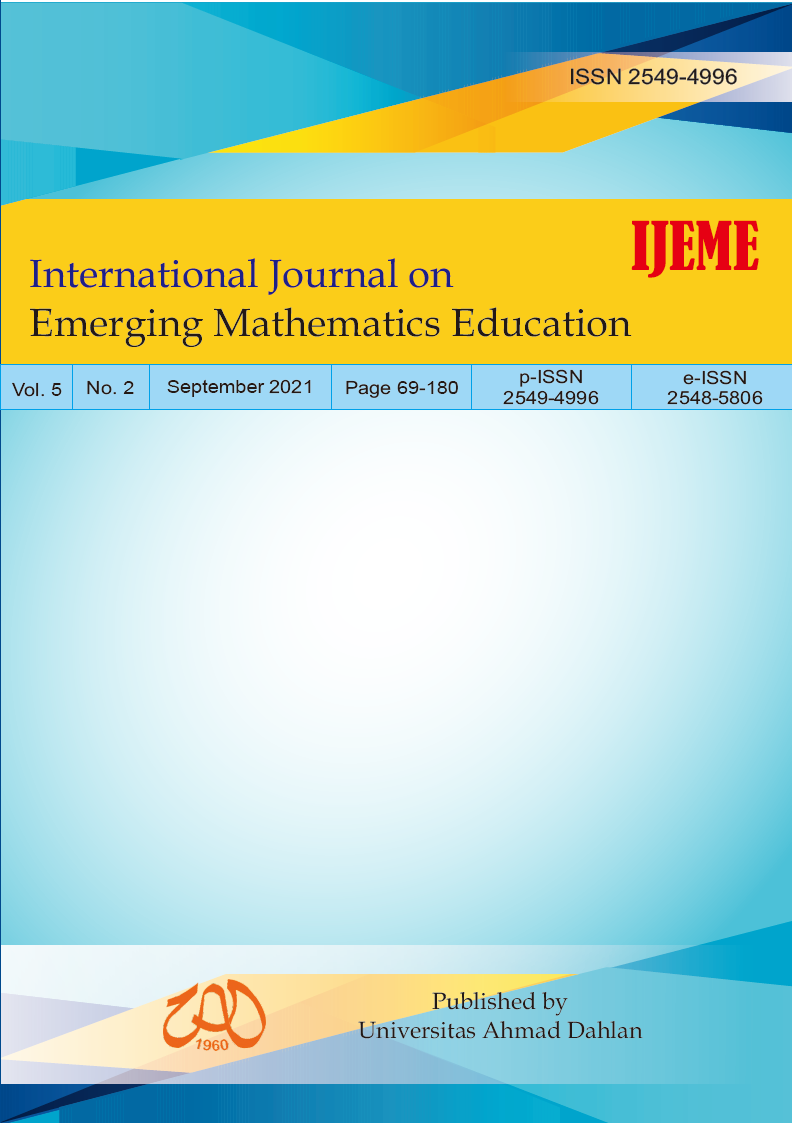Software-Based Circle Technology in Dinagat Geometry Class: A Single Subject Research
DOI:
https://doi.org/10.12928/ijeme.v5i2.20055Keywords:
Circle, Discriminant analysis, Single subject research, Software-based instruction technology.Abstract
Present study investigated the effectiveness of the use of technology software-based instruction in learning Circle Geometry, the extent of the students' interest on the use of this strategy, and designs a classification model through Discriminant Analysis forcasting students' performance as to having mastered or not the lessons based on their interest on the use of the strategy. The study utilized single subject research design to the thirty-one Grade 10 students in Llamera National High School, Dinagat Islands Division. Trend analysis and repeated ANOVA results revealed that most students' performance in circle geometry improved throughout the intervention of technology software-based instruction and the gap between the high achieving and low achieving students was reduced. Students also perceived high interest in learning geometry through the intervention. Indeed, technology software-based instruction recuperates knowledge in Circle Geometry. Accordingly, the capability to visualize the lesson through the software-based instruction is the best predictor of the students' mastery in circle geometry.
References
Alegria, M. (2017). Music as a Teaching Tool. George Lucas Educational Foundation. Retrieved from: http://benefits-of-using-music-in-the-classroom/.
Alkhateeb, M. A., & Al-Duwairi, A. M. (2019). The Effect of Using Mobile Applications (GeoGebra and Sketchpad) on the Students’ Achievement. International Electronic Journal of Mathematics Education, 14(3), 523-533.
Chen, R. W., & Chan, K. K. (2019). Using augmented reality flashcards to learn vocabulary in early childhood education. Journal of Educational Computing Research, 57(7), 1812-1831.
Department of Education. (2016). K to 12 Curriculum Guide in Mathematics. DepEd Complex, Pasig City. Retrieved from: http://lrmds.deped.gov.ph.
Ferron, J., & Rendina-Gobioff, G. (2014). Interrupted Time Series Design. Wiley StatsRef: Statistics Reference Online, 1-6.
Flemmer, C. (2009). Technology’s Influence on Student Centered Learning Environments. Boise State University. Retrieved from: https://sites.google.com/a/boisestate.edu/edtech504/Iflemmer.
Greefrath, G., Hertleif, C., & Siller, HS. (2018). Mathematical modelling with digital tools—a quantitative study on mathematising with dynamic geometry software. ZDM, 50, 233–244.
Gonzalez, G. & DeJarnette, A. (2013). Geometric Reasoning about a Circle Problem. The National Council of Teachers of Mathematics, Inc. 16 (8).
Hanna, E. (2018). Using geogebra to explore properties of circles in euclidean geometry. Masters Essays. 104. https://collected.jcu.edu/mastersessays/104.
Harackiewicz, J. M., Smith, J. L., & Priniski, S. J. (2016). Interest matters: The Importance of Promoting Interest in Education. Policy Insights Behav Brain Sci., 3(2), 220-227.
Heick, T. (2019). The Assimilation vs Accomodation of Knowledge. Teachthought: We Grow Teachers. Retrieved from https://www.teachthought.com/learning/assimilation-vs-accommodation-of-knowledge
Hitchcock, J. (2012). Single Case Design Brief. Design Options for Home Visiting Evaluation 4th Edition (pp. 1-9). Belmont, CA: Wadsworth/Thomson Learning.
Hursen, C. & Ertac, G. (2015). K 12 Students’ Attitudes towards Using Constructivism in History Lessons. Global Conference on Contemporary Issues in Education 2015, pp. 475-480.
McKenney, S., & Reeves, T. C. (2014). Educational design research. In Spector J., Merrill M., Elen J., Bishop M. (Eds.), Handbook of Research on Educational Communications and Technology (pp. 131-140). New York: Springer.
Ogbonnaya, U. & Alfred, C. (2017). The Impact of Using Geogebra to Teach Circle Geometry on Grade 11 Students’ Achievement. Institute of Science and Technology Education, University of South Africa.
Ramayah, T., Ahmad, N.H., Halim, H.A., Mohamed Zainal, S.R. (2010). Discriminant analysis: An illustrated example. African Journal of Business Management, 4(9), 1654-1667.
Romine, W., Sadler, T. D., Presley, M., & Klosterman, M. L. (2013). Student Interest in Technology and Science (SITS) Survey: Development, Validation, and Use of a New Instrument. International Journal of Science and Mathematics Education, 12(2), 261-283.
Siegle, D. (2015). Single-Subject Research. EPSY 5601. Retrieved from: www.delsiegle.info.
Shadaan, P. & Leong, K. E. (2013). Effectiveness of Using Geogebra on Students’ Understanding in Learning Circles. The Malaysian Online Journal of Educational Technology, 1(4), 43374506.
Stevens, J. P. (2002). Applied multivariate statistics for the social sciences, fourth edition. Mahwah, NJ: Lawrence Erlbaum Associates.
Schulte, P. L. (1996). A Definition of Constructivism. Science Scope, 20(6), 25-27.
Tay, M. K., & Mensah-Wonskyi, T. (2018). Effect of using Geogebra on senior high school students’ performance in circle theorems. African Journal of Educational Studies in mathematics and Sciences, 14, 1-18.
Downloads
Published
How to Cite
Issue
Section
License
License and Copyright Agreement
In submitting the manuscript to the journal, the authors certify that:
- They are authorized by their co-authors to enter into these arrangements.
- The work described has not been formally published before, except in the form of an abstract or as part of a published lecture, review, thesis, or overlay journal. Please also carefully read the International Journal on Emerging Mathematics Education (IJEME) Author Guidelines at http://journal.uad.ac.id/index.php/IJEME/about/submissions#authorGuidelines
- That it is not under consideration for publication elsewhere,
- That its publication has been approved by all the author(s) and by the responsible authorities, tacitly or explicitly, of the institutes where the work has been carried out.
- They secure the right to reproduce any material that has already been published or copyrighted elsewhere.
- They agree to the following license and copyright agreement.
Copyright
Authors who publish with the International Journal on Emerging Mathematics Education (IJEME) agree to the following terms:
- Authors retain copyright and grant the journal the right of first publication with the work simultaneously licensed under a Creative Commons Attribution License (CC BY-SA 4.0) that allows others to share the work with an acknowledgment of the work's authorship and initial publication in this journal.
- Authors are able to enter into separate, additional contractual arrangements for the non-exclusive distribution of the journal's published version of the work (e.g., post it to an institutional repository or publish it in a book), with an acknowledgment of its initial publication in this journal.
- Authors are permitted and encouraged to post their work online (e.g., in institutional repositories or on their website) prior to and during the submission process, as it can lead to productive exchanges, as well as earlier and greater citation of published work.
![]()
Ciptaan disebarluaskan di bawah Lisensi Creative Commons Atribusi-BerbagiSerupa 4.0 Internasional.





